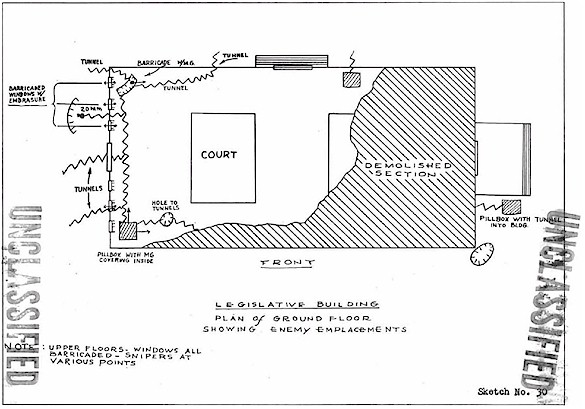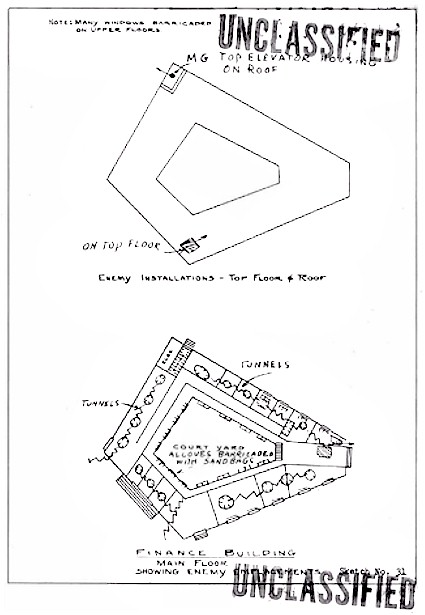|
The remainder of the story of the battle of
MANILA is one ot intense fighting about those buildings in the traingular
area -- Gral Luna, Burgos and Taft Avenue (See
Sketch No. 29).
The buildings were modern. earthquake proof
structures. very strongly built of heavily reinforced concrete. Many of
them are surrounded by parks and wide streets which preclude any except
direct assault across open ground. The buildings had been laboriously
converted by the Japanese into individual fortresses of the most
formidable type, with sandbagged gun emplacements and barricades in the
doors and windows oovering all approaches to each building as well as
adjacent ones. Machine guns within the buildings themselves were sited to
fire down corridors, stairways, and even inside rooms.
The reduction of these buildings was effected
concurrently. Each resisted fierce floor to floor, room to room an
hand to hand fighting. The 5th Cavalry, which had received mortar and
machine gun fire from the buildings on the 23d of February, placed
artillery concentrations upon the Agricultural Building throughout the
night of 23 - 24 February, and at dawn launched an attack in face of
exceptionally intense and accurate machine gun and small arms fire.
Failing to gain entrance into the building, four 105-mm self-propelled
howitzers, one battery of the 136th Field Artillery Battalion, and a
platoon of the 637th Tank Destroyer Battalion laid direct fire on the
building throughout the entire day of the 25th. On the 26th, supported by
the weapons just mentioned plus 155-mm howitzers, the 5th Cavalry made
several assaults upon the building, but each time was repulsed. Throughout
these assaults sniper fire was received from an enemy held apartment house
on San Luis street, and at 0635 on the 27th the Cavalry penetrated the
apartment house and eliminated the snipers. 4.2 inch mortars were then
brought into action and throughout the night 27 - 28 fired harassing
missions against enemy in the Agricultural Building. At 0800 February
28th, direct supporting fires were laid upon the building for one hour by
one battery of 155-mm howitzers. This was followed by another hour of
direct fire from tanks and tank destroyers, and after this another hour of
direct fire from 155-mm howitzers. This heavy gunfire partially
neutralized the Southern and Eastern portions of the building, and at 1230
cavalrymen stormed it with flame throwers, rocket 1aunchers, and small
arms. Throughout the afternoon of the 28th, fighting continued within the
building. Finally resistance was overcome, save for a group of enemy
holding out in 12 foot dugouts in the basement. By employing high
explosive charges and burning gasoline, our troops destroyed these enemy
and secured the Agricultural Building at 1425 March 1st.
The 148th Infantry was moved in from the Santa
Mesa area on February 24th, and on February 25th from positions along Taft
Avenue placed strong neutralizing fire on stubbornly held enemy positions
in the Legislative and Finance Buildings. This neutralization fire was
delivered by all heavy weapons of the 1st Battalion 148th Infantry, by two
batteries of the 136th Field Artillery Battalion (employing direct fire by
155-mm howitzers), three platoons of the 637th Tank Destroyer Battalion,
Company D of the 754th Tank Battalion with assault guns of the 716th Tank
Battalion attached, two platoons of the Regimental Cannon Company, and
Company A, 82d Chemical Battalion (4.2 inch mortars). By 1800 on the 25th,
it appeared that these buildings were substantially reduced. However, such
was not the case. On February 26th at 0930, after another heavy direct
fire preparation from 105-mm self-propelled howitzers and 155-mm
howitzers, the 1st Battalion 148th Infantry crossed Taft Avenue and by
1100 had gained entrance to the Legislative Building.

(See Sketch
No. 30). In difficult room to room and floor to floor fighting
among corridors, stairways, and against barricades and breastworks
defended by the enemy with light machine guns, rifles, and hand grenades,
troops of the 1st Battalion 148th Infantry slowly but steadily gained the
upper hand by the effective use of flame throwers and gasoline drums
ignited by thermite. Elements of the Battalion succeeded in reaching the
second floor where heavy enemy fire from prepared positions halted the
advance. At 1630 the troops were withdrawn from the building under cover
of a smoke screen to allow further neutralization by direct fire. Using
the same weapons as on the 26th, the 1st Battalion 148th Infantry on
February 27th at 1400 relaunched its attack against the Legislative
Building. By 1615 the troops again had secured the 1st f1oor, and by 1800
were in possession of the entire building with the exception of enemy in
tunnels and dugouts in the basement. On the 28th, these enemy were
destroyed and by noon on that date the Legislative Building was completely
occupied by our forces.
 Leaving Company A to occupy the Legislative
Building, the 1st Battalion 148th Infantry then directed its attention to
the Finance Building. On March 1st, heavy neutralization fire from 155-mm.
howitzers, tanks, and tank destroyers was placed on that building,
the last enemy stronghold in MANILA. This fire started at 1430 and lasted
for two hours, after which a broadcast in Japanese was made asking the
enemy to surrender. Twenty-two enemy came forth under the white flag. At
1000, 2nd March, after similar devastating fire, the Finance Building was
again assaulted, again unsuccessfully. American troops were withdrawn to
allow further gunfire to be placed on the now battered fortress. The
preparation lasted until 1300, after which Company C penetrated the
building and secured the 1st four floors by 1440. (See
Sketch No. 31). By 1800 March 2nd we held all of the building with
the exception of a small pocket on the top floor. This pocket was reduced
the next day. Seventy-four Japanese dead were found inside the building. Leaving Company A to occupy the Legislative
Building, the 1st Battalion 148th Infantry then directed its attention to
the Finance Building. On March 1st, heavy neutralization fire from 155-mm.
howitzers, tanks, and tank destroyers was placed on that building,
the last enemy stronghold in MANILA. This fire started at 1430 and lasted
for two hours, after which a broadcast in Japanese was made asking the
enemy to surrender. Twenty-two enemy came forth under the white flag. At
1000, 2nd March, after similar devastating fire, the Finance Building was
again assaulted, again unsuccessfully. American troops were withdrawn to
allow further gunfire to be placed on the now battered fortress. The
preparation lasted until 1300, after which Company C penetrated the
building and secured the 1st four floors by 1440. (See
Sketch No. 31). By 1800 March 2nd we held all of the building with
the exception of a small pocket on the top floor. This pocket was reduced
the next day. Seventy-four Japanese dead were found inside the building.
By 3d March, the once strong and elaborately
prepared Japanese defenses in MANILA had been reduced to merely a vestige
of their former solidity, and there remained only the enemy positions in
Wallace Park. That area was honey-combed with caves, trenches, and
connecting tunnels, and had been a source of harassment to elements of the
1st Cavalry Brigade and the 148th Infantry Regiment from the 23d of
February to the 3d of March. After the reduction of the Agricultural
Building by the 5th Cavalry, and the Legislative Building by the 1st
Battalion 148th Infantry, those units continued to fire upon Japanese
positions in Wallace Park. Upon the fall of the Finance Building, the
148th Infantry moved into the Wallace Park area and destroyed the small
groups of enemy remaining in dugouts and trenches.
On March 3d, the Commanding General of the XIV
Corps, from the Corps Command Post, which all during the combat in MANILA
had been located at Grace Park, sent a teletype message to the Commanding
General of the Sixth Army stating that all organized resistance in the
city had ceased. Thus ended the Battle of Manila. It had lasted from
January 30th until March 3d, and required the fighting strength of three
U. S. Divisions to bring almost complete annihilation to the enemy
garrison. Japanese dead numbered 16,665.
|

